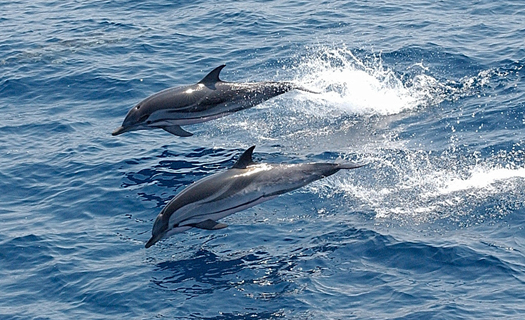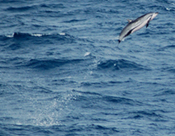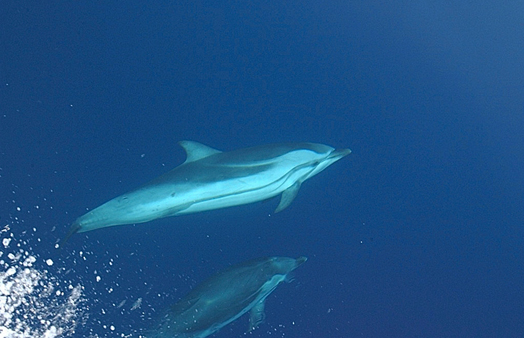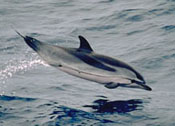Striped Dolphin (Stenella coeruleoalba)
Status | Taxonomy | Species Description | Habitat | Distribution |
Population Trends | Threats | Conservation Efforts | Regulatory Overview |
Key Documents | More Info
 Striped Dolphin (Stenella coeruleoalba) Photo: NMFS Southeast Fisheries Science Center |
|
Did You Know? · Striped dolphins' scientific name (Stenella coeruleoalba) comes from the Latin words "caeruleus" and "albus," which mean "sky blue" and "white," respectively, referring to the animals distinct color pattern on the dorsal and lateral portions of their body. |
|
 Striped dolphin leaping out of the water* *click for larger image (Stenella coeruleoalba) Photo: Howard Goldstein, NOAA Southwest Fisheries Science Center, Protected Resources Division, STAR 2006 |
Status
MMPA - Striped dolphins, like all marine mammals, are protected under the MMPA.
Taxonomy
Kingdom: Animalia
Phylum: Chordata
Class: Mammalia
Order: Cetacea
Family: Delphinidae
Genus: Stenella
Species: coeruleoalba
Species Description
Striped dolphins are some of the most abundant and widespread dolphins in the world. These dolphins can reach lengths of about 9 ft (2.7 m) and weigh up to 350 lbs (160 kg) for males and 8 ft (2.4 m) and 330 lbs (150 kg) for females. They have a small to medium-sized robust, sleek body with a long, defined beak and round "melon" (forehead). The "dorsal" fin is "falcate", tall, and located mid-back. Their distinct and striking coloration pattern with a complex of bold thin stripes that extend from the eye to the flipper and another set of stripes down the side of the body to the anal region distinguishes it from other cetacean species, and is the origin of its common name. The beak, tapered flipper, tail, and back, or cape, are dark blue/gray. The area just above the side stripe is bluish or light gray and creates a contrasting shoulder blaze that curves back and up toward the animal's dorsal fin. The ventral side is white to pinkish, and much lighter than the rest of the body. The markings and coloration of this species may vary by individual and geographical location. Calves and juveniles may have more muted colorations and patterns.
Striped dolphins are usually found in tight, cohesive groups averaging between 25 and 100 individuals, but have been occasionally seen in larger groups of up to several hundred and even thousands of animals. Within these schools there is a complex system of individuals that may be organized by age, sex, and breeding status. They rarely associate with other species of whales, dolphins, and seabirds. Their surface behavior is often characterized as sociable, athletic, energetic, active, and nimble with rapid swimming. They can often be observed breaching, "roto-tailing" (a circular motion using the tail while jumping out of the water), jumping, and leaping up over 20 ft (7 m) above the surface of the water.
Striped dolphins feed on a diverse diet consisting of various species of relatively small, closely-packed, midwater, "benthopelagic" and/or "pelagic" shoaling/schooling fish (e.g., "myctophids" and cod) and cephalopods (e.g., squid and octopus) throughout the water column. They are capable of diving to at least 2,300 ft (700 m). This species has 43-50 pairs of small, sharp, conical teeth in the upper and lower jaws.
Striped dolphins become sexually mature at about 7 ft (2.1-2.2 m) in length, between the ages of 5-13 years for females and 7-15 years for males. Their mating system is generally unknown, but thought to be "polygynous". They give birth to a single 3 ft (1 m) long calf during the summer or autumn after a gestation period of about one year. The interval between giving birth to calves is usually 3-4 years, and lactation lasts 12-18 months. The estimated lifespan of these dolphins is up to 58 years.
 Striped Dolphin Range Map (click for larger view PDF) |
Habitat
Striped dolphins prefer highly productive tropical to warm temperate waters (52-84° F or 10-26° C) that are oceanic and deep. These dolphins are often linked to upwelling areas and convergence zones.
Distribution
Striped dolphins have a cosmopolitan distribution. They are mainly found in tropical and warm temperate waters seaward of the continental shelf from 50° North to 40° South. Their range includes Greenland, northern Europe (United Kingdom, Denmark), the Mediterranean Sea, and Japan to Argentina, South Africa, Western Australia, and New Zealand. This species occurs in the U.S. off the west coast, in the northwestern Atlantic and in the Gulf of Mexico. They can also be found in the waters off of Hawaii, but do not occur in the colder temperate and boreal waters of Alaska. This species has been documented outside their normal range in areas such as the Faroe Islands, southern Greenland, the Kamchatka Peninsula, and Prince Edward Island.
 Striped Dolphin (Stenella coeruleoalba) Photo: NMFS Southeast Fisheries Science Center |
Population Trends
Striped dolphins are abundant and widespread throughout the world as well as in offshore U.S. waters. For management purposes, striped dolphins inhabiting U.S. waters have been divided into four stocks: the California/Oregon/Washington stock, the Hawaiian stock, the Northern Gulf of Mexico stock, and the Western North Atlantic stock.
Recent abundance estimates of U.S. stocks are 9,000-14,000 for the U.S. west coast (California/ Oregon/ Washington), 7,000-10,500 around the Hawaiian Islands, 4,500 to 6,500 for the northern Gulf of Mexico, and 68,500-94,500 for the western North Atlantic. It is estimated that 1 million striped dolphins occur in the eastern tropical Pacific. Populations in the western North Pacific and the Mediterranean are in serious decline due to hunting, over-fishing, and disease. There are insufficient data to determine the population trends for this species.
 Striped Dolphin (Stenella coeruleoalba) Photo: Scott Hill, NOAA Corps |
Threats
Striped dolphins are taken as bycatch or interact with a number of fisheries, such as in pelagic trawls, gillnets, driftnets, purse seine nets, and hand-harpoons. They have been subjected to drive hunts in Japan and taken in the Caribbean and Sri Lanka. During the mid-twentieth century it is estimated that as many as 21,000 animals were caught and killed each year. In the early 1990s, more than 1,000 dolphins died in the Mediterranean Sea from a "morbillivirus epizootic", which may have been triggered by pollution (e.g., organochlorines), and fewer available prey. Environmental toxins and contaminants lower the disease immunity of these animals.
Conservation Efforts
The IUCN Red List of Threatened Species ![]() considers this species "Lower Risk Conservation Dependent."
considers this species "Lower Risk Conservation Dependent."
Regulatory Overview
This species is protected under the Marine Mammal Protection Act of 1972, as amended.
Key Documents
(All documents are in PDF format.)
| Title | Federal Register | Date |
|---|---|---|
| Stock Assessment Reports | n/a | various |
- Listen to Striped Dolphin Sounds from NMFS Southwest Fisheries Science Center
- IUCN Striped Dolphin Species Information

- Ocean Biogeographic Information System (OBIS-SEAMAP) Striped Dolphin Species Profile

References:
- Reeves, R. R., P. A. Folkens, et al. (2002). Guide to Marine Mammals of the World. New York, Alfred A. Knopf. p.380-383.
- Jefferson, T. A, M. A. Webber, and R. L. Pitman. (2008). Marine Mammals of the World, A Comprehensive Guide to their Identification. Amsterdam, Elsevier. p. 241-244.
- Shirihai, H. and B. Jarrett (2006). Whales, Dolphins and Other Marine Mammals of the World. Princeton, Princeton University Press. p.185-188.